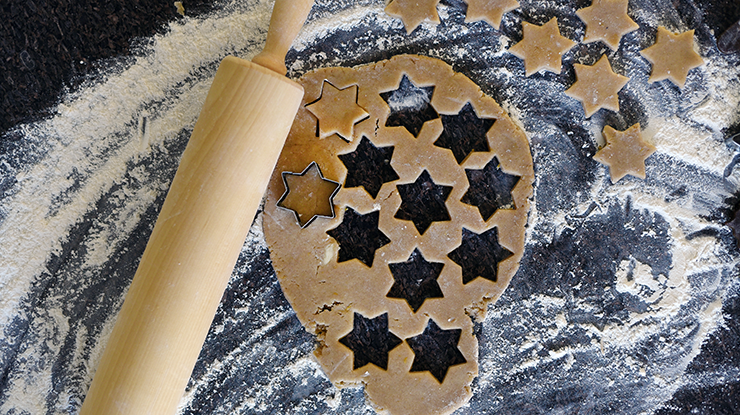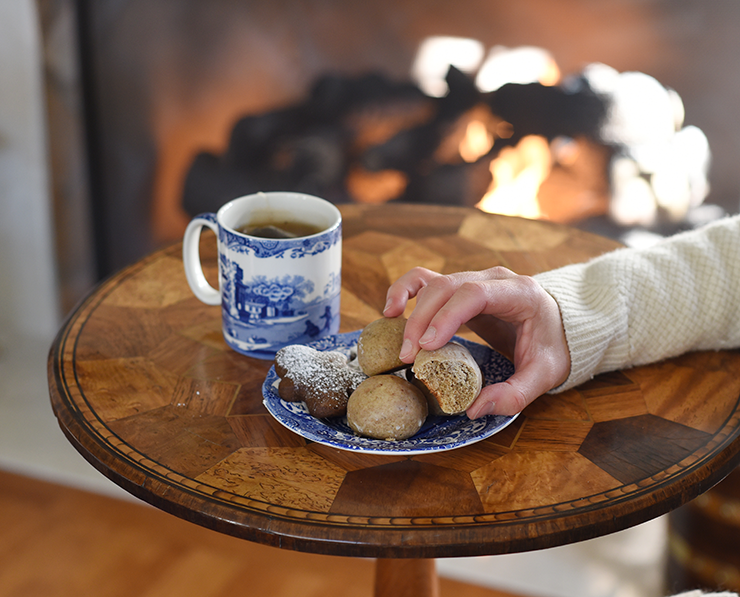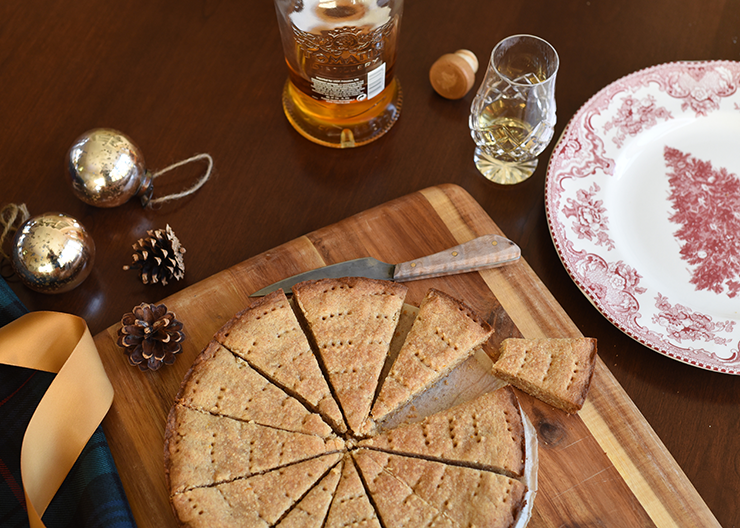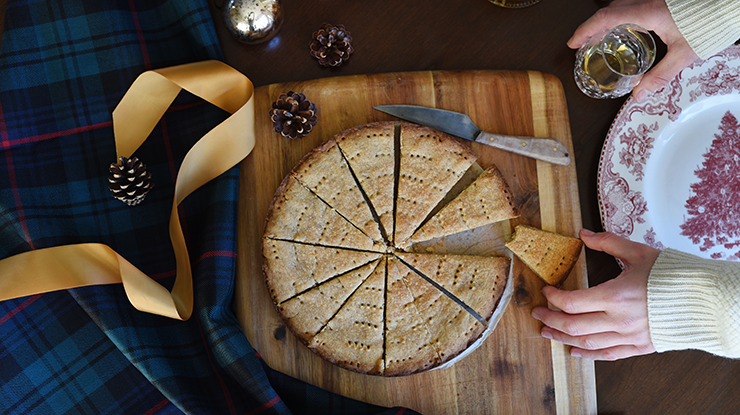Winter’s sweet treats past and present
Words Ellie Shortt
Photography Don Denton
It was a cold and blustery day. The beating rain quickly turned into slushy snow as a weary traveller fought his way through the looming darkness. The sun set so early now—both the nightfall and the storm caught him off guard. Protected by a thick cape, the traveller pulled the hood over his head, and wrapped the woolen fabric around him to cover a simple wooden box he carried under his arm.
The cobblestone streets were abuzz with activity. Other townsfolk seeking shelter scurried excitedly in a similar fashion, all carrying boxes, satchels and parcels containing precious goods.
The traveller arrived at his destination, a house of grey stone, and knocked on the heavy wooden door. The familiar smiles of loved ones welcomed him inside. He removed his cloak and children’s faces lit up as they saw the wooden box. They knew what was inside. It was the same treat their uncle brought every year: an assortment of cookies he had collected from some of the village’s best bakers. He set this prized package on a long table decorated with candles, wine, meats, cheeses, nuts and even some fruits from the late fall harvest.
The traveller and his kinsmen all sat down to feast, and toasted to life, death, natural cycles and the sun, which showed for the shortest amount of time of the year on this auspicious and important day.
Scenes like this would have been common during the 10th and 11th centuries, as folks from all over the world gathered to celebrate the winter solstice. Whether honoured with large village-wide festivities or in smaller circles of families and neighbours, it was a day to acknowledge the changing of seasons.
Most of the rituals revolved around food—gathering, sorting, storing and feasting—as people prepared for what was considered a time of famine. The wintry weather wasn’t ideal to grow crops or hunt, so people gathered to prepare their larders while sharing the last of the harvest throughout their communities.
Solstice often meant the arrival of the first frost, so livestock were killed and their meat tenderized for the winter, while fermented beverages like beer and wine, which had been brewed in the spring, were finally ready to drink.
By the Middle Ages, with the spread of Christianity, the Christmas holiday took over traditional solstice rituals throughout much of Europe, but some of the older feasting traditions still remained, including the exchange of cookies, which were easily stored and transported, and then offered as gifts during various winter holidays.
It is thought that cookies as we recognize them today originated in ancient Persia, where, in the 7th century, sugar became relatively common. Cookies spread to Europe through the Umayyad conquest of Hispania, and soon thereafter were common in all levels of society throughout Europe, from royal cuisine to street vendors.

Refined wheat flour would have been reserved for more prestigious households, as it was time-consuming and costly to generate, so more accessible regional flours, such as those made from ground beans and nuts as well as rustic grains like oat and rye, were likely common ingredients, even if combined with finer wheat flour for special occasions. Other ingredients like honey were mixed in as well, to cut the cost of the then still scarce and pricey sugar.
Additional flavourings would have been localized and often included aromatic botanicals, berries, seeds, barks and roots of woodlands and fields, until seasonings like cinnamon, nutmeg, cardamom and clove became more prevalent due to exploration, expansion, colonization and trade.
In medieval Russia, for example, spiced honey cookies were given as good luck charms and fertility tokens, and during winter festivities and feasts they were gifted to family and friends, even the animals. These pryanik (stemming from the Old Russian word “pryany,” meaning “spicy”) were likely made with rye flour mixed with honey, herbs, dried berries or berry juice, and were possibly a forebearer to gingerbread men, which became popular in the following centuries, particularly in the Elizabethan court, where they were made to emulate visiting nobles.
Similar cookies to pryanik can be found throughout Europe, such as pernik in Czechia and Slovakia, pierniczki in Poland, and pfeffernüsse in Germany, which by the 17th century were linked to the Feast of Sinterklaas, celebrated every December 5 in the Netherlands and December 6 in Germany and Belgium.
In medieval Scotland, farmers celebrated the winter solstice with blazing bonfires and made a simple cake of ground oats, butter and honey, in the shape of a sun with notches to represent the rays. Evolving to include refined wheat flour and sugar, we now recognize this beloved biscuit as modern-day shortbread, which, of course, can be found in almost every Christmas cookie exchange and festive treat box.
Another Yuletide staple is that of the Linzerkekse, which was first enjoyed as a larger tart with a lattice crust, and then later developed into a cookie made of a rich buttery dough accentuated by almond flour, lemon zest and spices, and traditionally filled with blackcurrant preserves, like its Linzertorte predecessor, which was first noted in 17th-century Austria.
Whether celebrating solstice, the Feast of Sinterklaas or Christmas as we know it now, the sharing of cookies has been a long-cherished tradition of wintry gift-giving across many cultures, religions and regions. With favourite recipes passed down through generations like treasured heirlooms, cookies—especially those enjoyed during the winter months—are so much more than a dessert. They’re a mouthful of meaningful memories, a cosy comfort on a cold day, and a sweet treat to accompany a good book by a blazing fire, many flavours carrying stories and folklore of their own.
As you hunker down on these darker, colder days, gathering, sorting, storing and feasting, keep in your thoughts the image of the weary cloaked traveller, honour the long and worldly journey that cookies have taken to find a place so solidified in our contemporary traditions, and know that there are few greater gifts than that of a loving treat, made with kind hands and a generous heart.

Butter Rum Glazed Pryanik
Ingredients
Cookies:
- 1 ½ cups unbleached all-purpose flour
- 1 ½ cups rye flour
- 3 tsp baking powder
- 2 tsp ground ginger
- 1 tsp ground cinnamon
- ½ tsp ground cardamom
- ½ tsp freshly grated nutmeg
- ¼ tsp ground allspice
- 1⁄8 tsp salt
- 1 large egg
- 2 large egg yolks
- ½ cup butter, melted
- 1 tsp pure vanilla extract
- ½ cup honey
- Directions
Glaze:
- ⅔ cup confectioners’ sugar, sifted
- 1 Tbsp unsalted butter, melted
- 1 Tbsp dark rum
- 1 tsp water
- Allspice, cinnamon or freshly grated nutmeg, for garnish
In a medium bowl, combine the flours, baking powder, spices and salt, and set aside.
In a separate bowl, either using an electric mixer or by hand, beat together 1 whole egg, 2 egg yolks, melted butter, vanilla and honey.
Slowly add the flour mixture to the wet mixture, and stir until a smooth and solid mass of dough forms. Place the dough in the refrigerator to cool for about 30 minutes.
Meanwhile, heat your oven to 350 F and line one or two baking sheets (depending on how big your baking sheets/oven are) with parchment paper.
Using a small cookie scoop, portion out mounds of dough and roll them in your hands until they are completely smooth balls (there will be about 30 total). Place on the prepared baking sheets, leaving 2 inches between each cookie. They will flatten out somewhat during baking, but still retain a domed shape.
Bake for 10 to 15 minutes, or until just golden, rotating the baking sheets halfway through for even baking. Remove from the oven and allow to sit on the baking sheet for a few minutes while you make the glaze (it needs to be brushed on while the cookies are still warm).
In a small bowl, whisk together the sugar, butter and rum until smooth. The glaze will thicken slightly if it sits, so stir through a little warm water if you need to—it should be the consistency of runny honey.
Transfer the slightly cooled (but still warm) cookies to a wire rack, then brush the glaze all over the cookies with a pastry brush and allow to cool completely. Sprinkle with fresh ground nutmeg, or a spice of your choosing, to garnish. The cookies should keep for up to five days in an airtight container.

Orange Clove Shortbread
Ingredients
- 200 g (about ¾ cup) unsalted butter, softened
- ⅓ cup granulated sugar
- ¼ cup honey
- 1 tsp pure vanilla extract
- Zest of 1 large orange
- 1 ⅓ cups unbleached all-purpose flour
- 1 cup fine oat flour
- 1 tsp sea salt
- ¼ tsp ground clove
Directions
- Preheat the oven to 325 F. Lightly grease a 9-inch springform pan and line the bottom with a piece of parchment paper.
- Using an electric mixer (either handheld or stand), beat the butter, sugar, honey, vanilla and orange zest until light and fluffy (about 3 minutes), scraping the bowl as needed.
- In a separate bowl, combine the flours with the salt and clove, and slowly stir into the wet mixture until the dough starts to clump together.
- Press the dough into the prepared springform pan so that the top is as smooth and even as possible. Using a fork, poke holes all around it, and then cut the dough into 12 segments.
- Place in the oven and bake for 35 minutes, or until slightly brown and crispy on the edges. Halfway through baking, you may also want to redo your cuts and redefine your wedges (it will make for an easier cut/separation later).
- Remove from the oven, and allow to cool slightly before carefully removing from the springform pan onto a cutting board or clean surface. Cut through the slices again while the shortbread is still a bit warm, and transfer the wedges to a rack to cool. Store for up to a week in an airtight container, or freeze for longer storage (the flavour improves as the shortbread ages).


 Adventures in America’s Wild West
Adventures in America’s Wild West